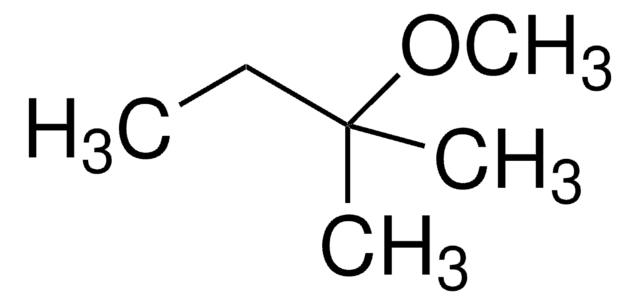293210
tert-Butyl méthyl éther
HPLC grade, suitable for HPLC, 99.8%
Synonyme(s) :
MTBE, Éther méthylique tert-butylique
About This Item
Produits recommandés
Qualité
HPLC grade
Densité de vapeur
3.1 (vs air)
Pression de vapeur
4.05 psi ( 20 °C)
Essai
99.8%
Forme
liquid
Température d'inflammation spontanée
705 °F
Produit purifié par
glass distillation
Limite d'explosivité
15.1 %
Technique(s)
HPLC: suitable
Impuretés
<0.010% water
Résidus d'évap.
<0.0003%
Indice de réfraction
n20/D 1.369 (lit.)
pb
55-56 °C (lit.)
55-56 °C
Densité
0.74 g/mL at 25 °C (lit.)
λ
H2O reference
Absorption UV
λ: 210 nm Amax: 1.00
λ: 230 nm Amax: 0.40
λ: 250 nm Amax: 0.10
λ: 320-400 nm Amax: 0.01
Chaîne SMILES
COC(C)(C)C
InChI
1S/C5H12O/c1-5(2,3)6-4/h1-4H3
Clé InChI
BZLVMXJERCGZMT-UHFFFAOYSA-N
Vous recherchez des produits similaires ? Visite Guide de comparaison des produits
Mention d'avertissement
Danger
Mentions de danger
Conseils de prudence
Classification des risques
Flam. Liq. 2 - Skin Irrit. 2
Code de la classe de stockage
3 - Flammable liquids
Classe de danger pour l'eau (WGK)
WGK 1
Point d'éclair (°F)
-18.4 °F - closed cup
Point d'éclair (°C)
-28 °C - closed cup
Faites votre choix parmi les versions les plus récentes :
Déjà en possession de ce produit ?
Retrouvez la documentation relative aux produits que vous avez récemment achetés dans la Bibliothèque de documents.
Notre équipe de scientifiques dispose d'une expérience dans tous les secteurs de la recherche, notamment en sciences de la vie, science des matériaux, synthèse chimique, chromatographie, analyse et dans de nombreux autres domaines..
Contacter notre Service technique










